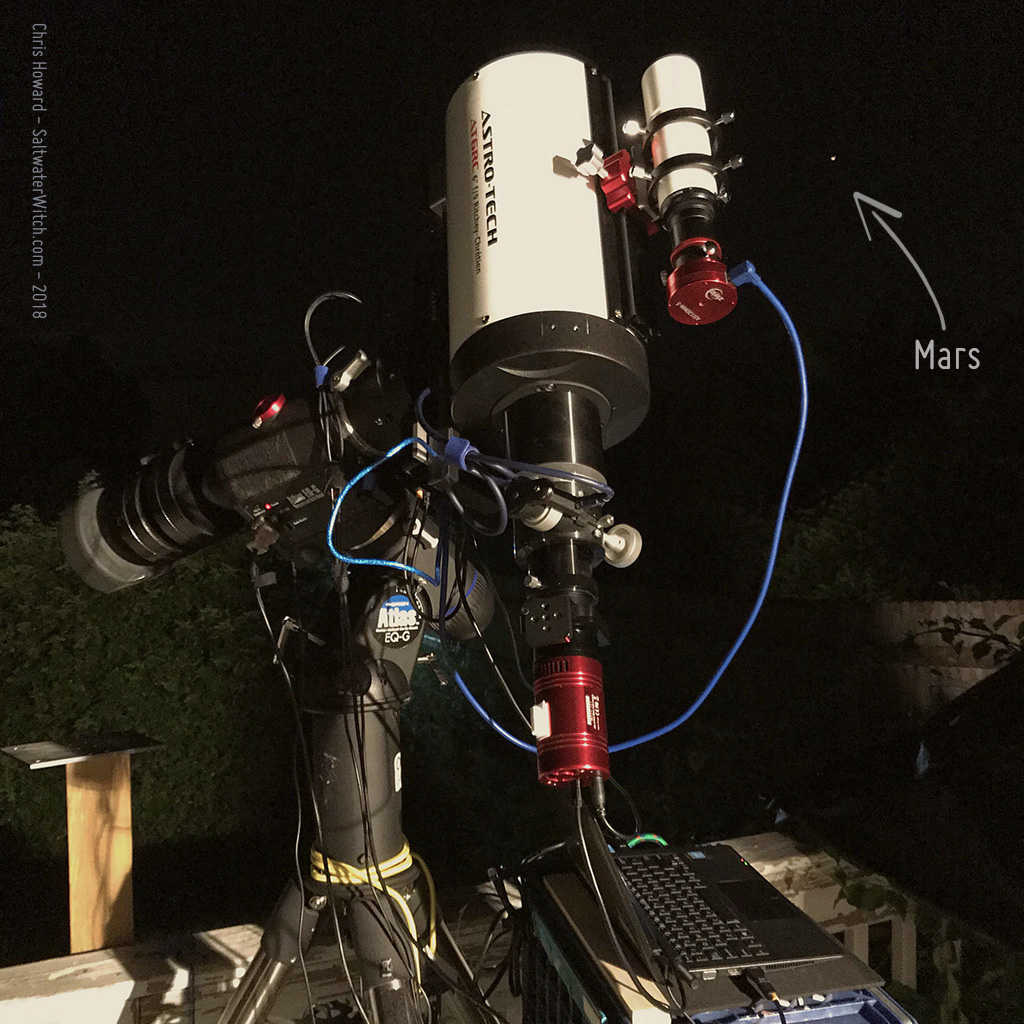Astro Session - November 8, 2018
First shot of the season in the constellation Orion! I set up the AstroTech RC scope (6"/152mm aperture f/9) with my narrowband imaging train, Atik 414EX, ZWO filter wheel with Clear, Ha, OIII, SII & IR685, William Optics 0.8x field flattener/reducer that brings the AT6RC to f/7.2 at 1080mm focal length. With the Atik's 6.45μ pixels this has my resolution at 1.23 arcseconds per pixel, and a field of view of 0.48° x 0.36°.
Here are some shots of my set up last night, before nightfall, and in the middle of the narrowband run with 600-second exposures.
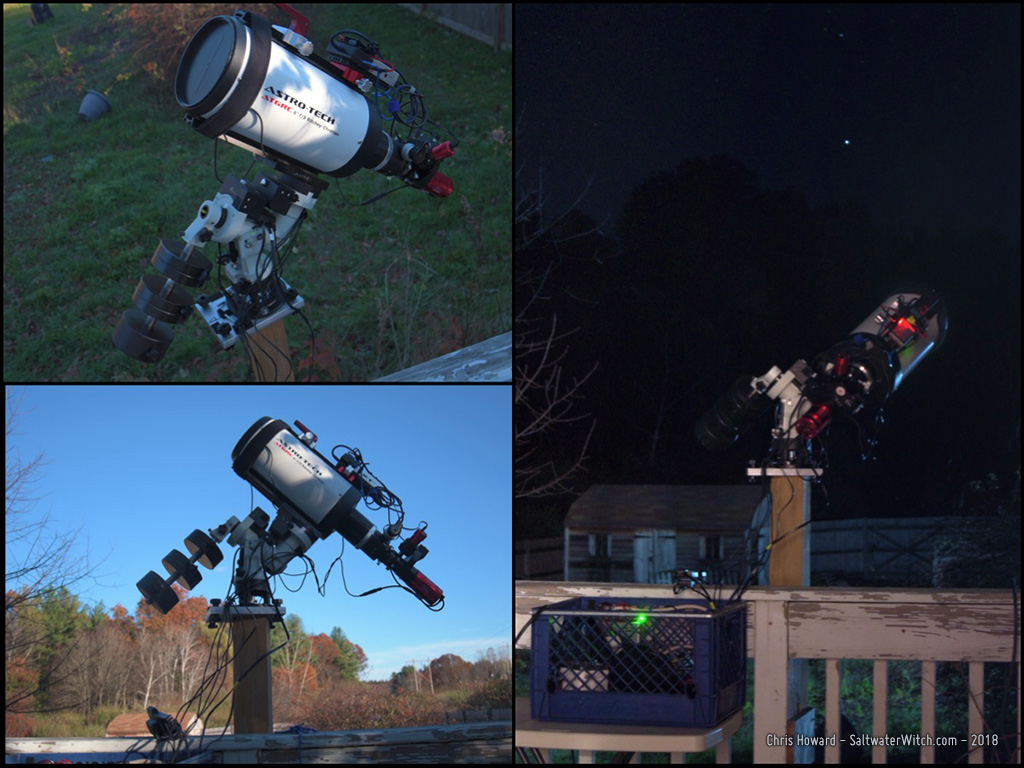
The 1000mm+ focal length did get me wonderfully close to the Horsehead Nebula (B33) and the reflection nebula NGC 2023 (bottom left) in the constellation Orion. This is what 46 stacked 600 second hydrogen-alpha frames will get you if you stretch things a bit too much and don't use any calibration frames. That would reduce the noise/graininess somewhat. Anyway, pretty happy with this. (46 x 600 second exposures in Ha, Atik 414EX mono CCD at -10C, Astronomik 12nm Ha filter, AstroTech AT6RC f/9 Ritchey-Chrétien + WO Flat6A f/7.2, iOptron CEM25P EQ mount, Orion OAG + ZWO ASI120MM-Mini guide cam, Stellarmate OS (INDI/KStars/Ekos) running on Raspberry Pi 3b+. Stacked in DSS, processed in Photoshop CC 2019).
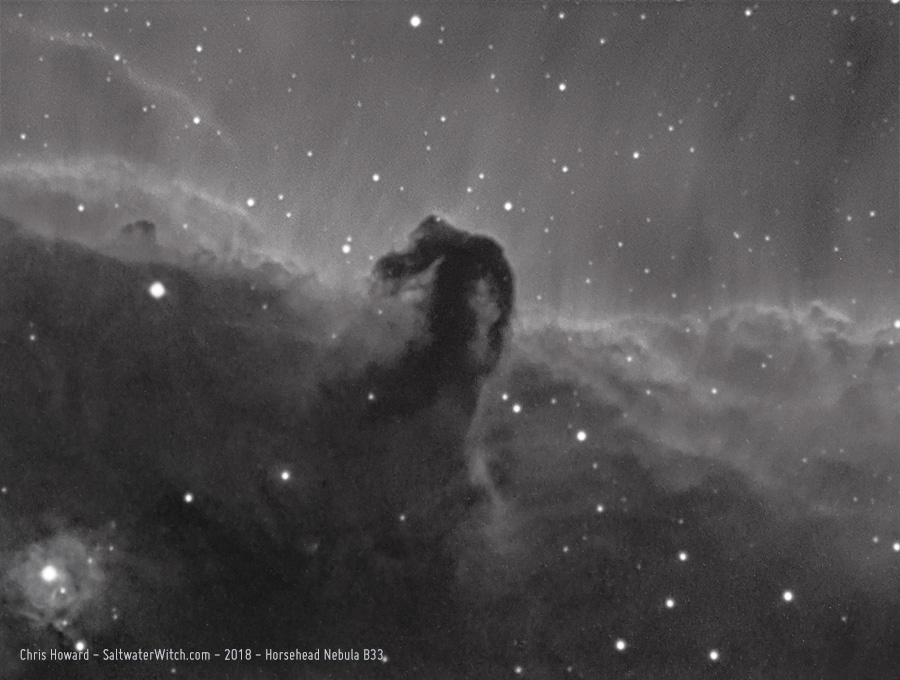
I stretched the hell out of this stack of 46 x 600 second subs, mainly to see what the data would show if I went out of my way to bring out the details. I also didn't use dark frames with this--so that's worth a try. The Atik 414EX at -10C or cooler is very clean, though. I usually don't gain a lot with calibration frames, but in this case even a little will improve the noisiness.
I don't use the AT6RC scope that much, mostly because when paired with the cameras I have the resolution is oversampled crap. The Atik is the only one that's right in there at 1.23 arcseconds/pixel, and that's with the 0.8x field flattener/reducer.
Another point (or set of points) I would like to make is the Astro-Tech 6" f/9 Ritchey-Chrétien is a $400 scope, and I'm pretty impressed with the light and contrast it managed to pull out of the night sky. Some of the credit certainly goes to the Atik CCD, which really is an amazing little camera. The sub-$1000 iOptron CEM25P has no problem with long exposure times. Along with the $129 12nm Astronomik Ha filter, this is a very inexpensive narrowband setup. The point being you don't need to spend a raft-load of cash to start capturing those beautiful HII regions, supernova remnants, and other wonders in the night sky.
My tips for the iOptron CEM25P--or what I've learned over the last two years: For narrowband, I normally shoot 5, 10 or 20 minute subs depending on the brightness of the target, and the iOptron has no problem. However, there are a few steps I go through in order to get very long exposures from this mount. 1) a solid foundation--solid tripod or better. I don't have a concrete or steel pier, but I do have a treated 4x4 solidly in the ground, and it doesn't move. 2) More counterweights, closer to the center of balance. I try to use more weight, and keep them as close to the top of the counterweight shaft as possible. I know it's tempting to use fewer weights farther out, but trust me on this--and don't worry about the bushings that carry all the weight. They can handle far more than you'll ever bolt on. It's minor, but it does smooth out tiny movements the scope has to make--so improved guiding. 3) Balance, balance, balance. You want a perfectly balanced scope and equipment. Don't bias weight to one side; don't get your gear "close enough". If you'll permit me to anthropomorphize the CEM25P for a moment, you want the mount and motors to think they're moving nothing at all, and for that you'll need to balance the shit out of your payload. I use small 100g camera gimbal weights to even the load--balance is that important. (https://www.amazon.com/gp/product/B0797S81HR)
Okay, I also took some subs of the Triangulum Galaxy core (M33) while setting up and getting into focus--testing out shooting in 2x2 binning, which reduces the resolution by half.
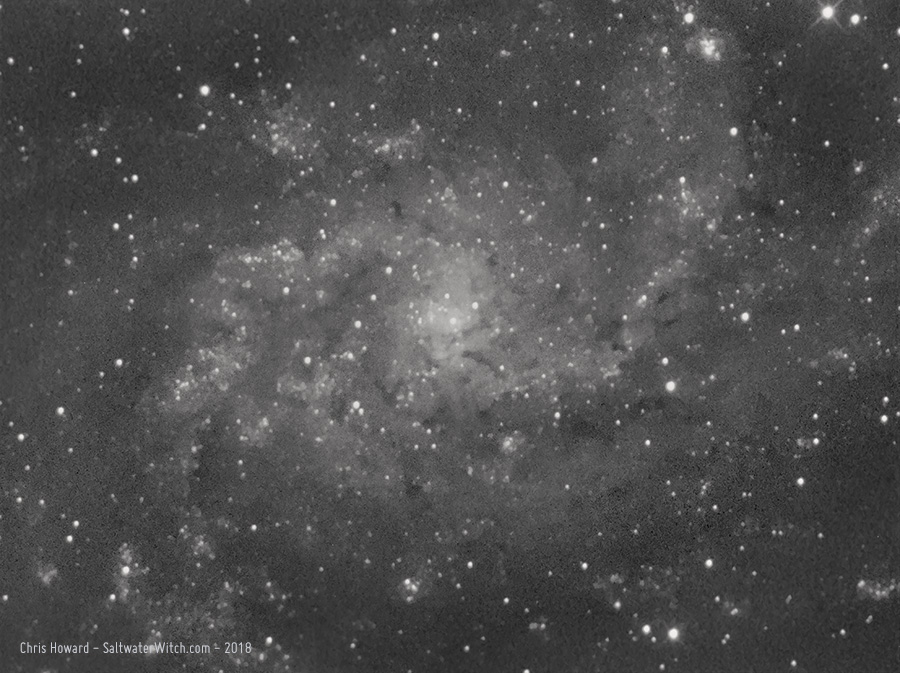
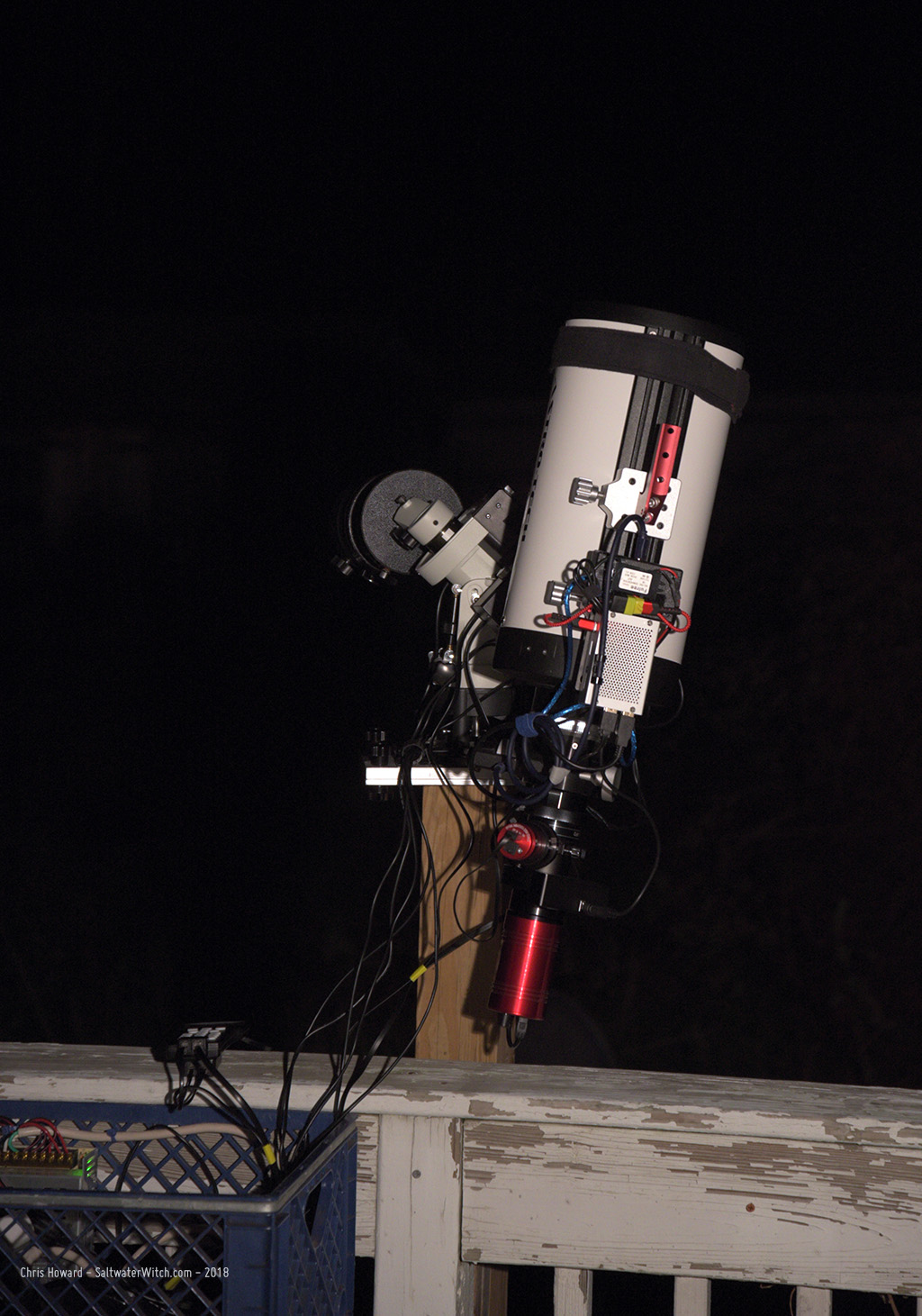
Posted November 9, 2018
Astro Session: October 30, 2018
I had several hours of clear skies, still relatively dark before the moon rose, and I set up the William Optics GT81 and ZWO ASI071MC color camera to take a bunch of subs of M33 and M45--Triangulum Galaxy and the Pleiades, two of my favorite targets this time of year--but this is my first time shooting these with the ZWO ASI071MC cooled color camera, and the resulting images show how amazing the ZWO is. (ZWO ASI071MC running at -10C, William Optics GT81 + WO Flat 6A II f/4.7, iOptron CEM25P EQ mount, Orion OAG + ZWO ASI120MM-S guide cam, Stellarmate OS (INDI/KStars/Ekos) running on Raspberry Pi 3b+).
The Pleiades, M45, also known as "The Seven Sisters" and in Japanese as Subaru (昴). It's one of the most identifiable objects in the night sky, but it's more than just a loose group of stars. Located in the constellation Taurus, the Pleiades is a nearby open star cluster mostly made up of a batch of relatively young B-type stars amid (or behind) a reflection nebula that appears to surround and fill the space between the stars with veil-like sheets and threads. (WilliamOptics GT81, ZWO ASI071MC: 60 x 60 second and 60 x 120 second exposures, unity gain).
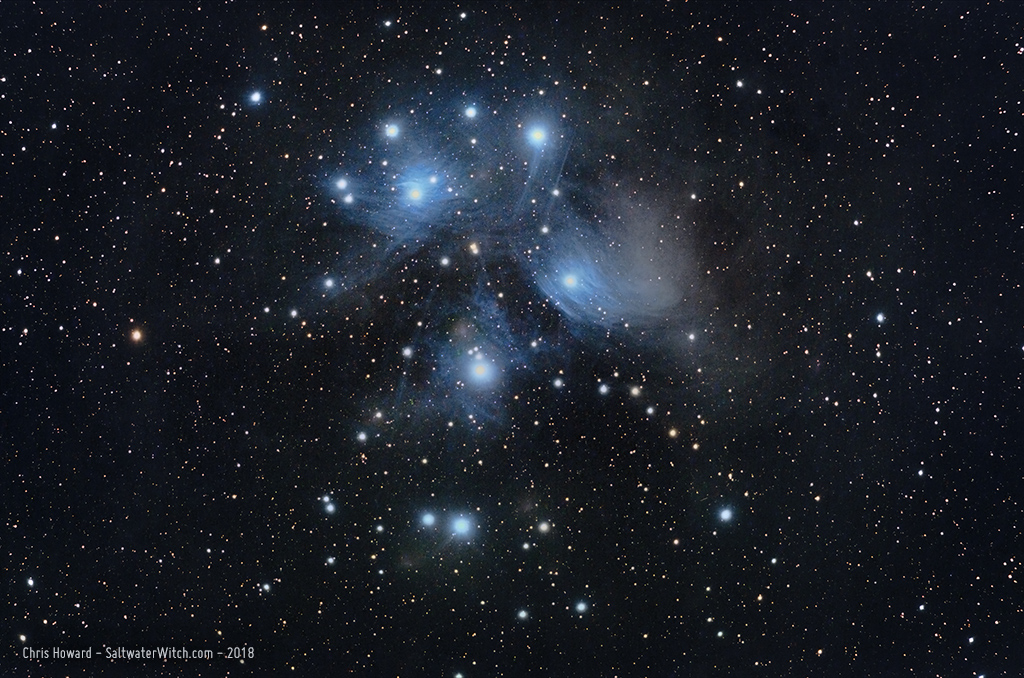
Triangulum Galaxy, M33, is a nearby spiral galaxy--around 3 million lightyears away, with as many as 40 billion stars. It's the third largest galaxy in our local group, and appears to be bound up in Andromeda's gravitational pull. It also contains some amazing nebulae and other deep space objects, e.g., NGC 604 is a massive H II region--that's the bright pinkish blob, the size of a large star, at the lower left side of the galactic spiral. Keep in mind that nearly every star-like point of light in this image is actually a star in the Milky Way, our own galaxy. (WilliamOptics GT81, ZWO ASI071MC: 90 x 60 second exposures, unity gain).
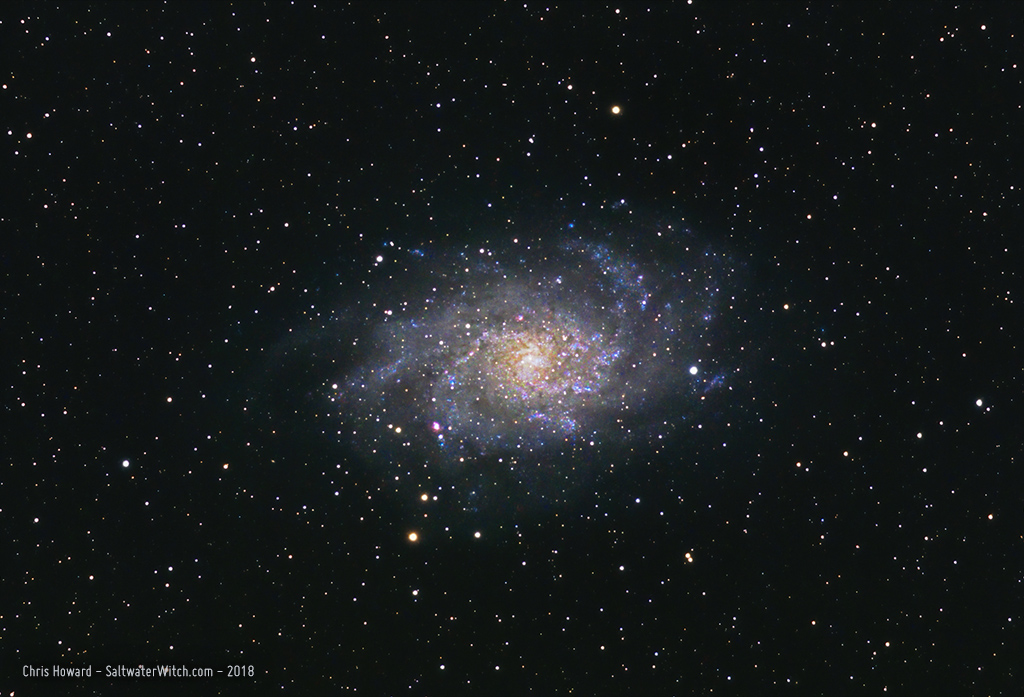
Posted October 30, 2018
Astro Session: October 21, 2018
I took some test shots of the Pacman Nebula in the constellation Cassiopeia. This is with the ZWO ASI071MC cooled color camera--see a pic of the setup below. There's a bright moon out there, so it's not a great night for color or RGB imaging, but I wanted to get the off-axis guiding dialed in for this imaging train: William Optics FLAT 6A II + Orion thin OAG + 2" filter drawer + ZWO ASI071MC. With off-axis guiding it's all about getting the primary and guide cameras both focused, and I did! (10 x 60 second and 4 x 240 second exposures, ZWO ASI071MC camera running at -10C, William Optics GT81 + WO Flat 6A II f/4.7, CEM25P EQ mount, Orion OAG + ZWO ASI120MM-S guide cam, Stellarmate OS (INDI/KStars/Ekos) running on Raspberry Pi 3b+).
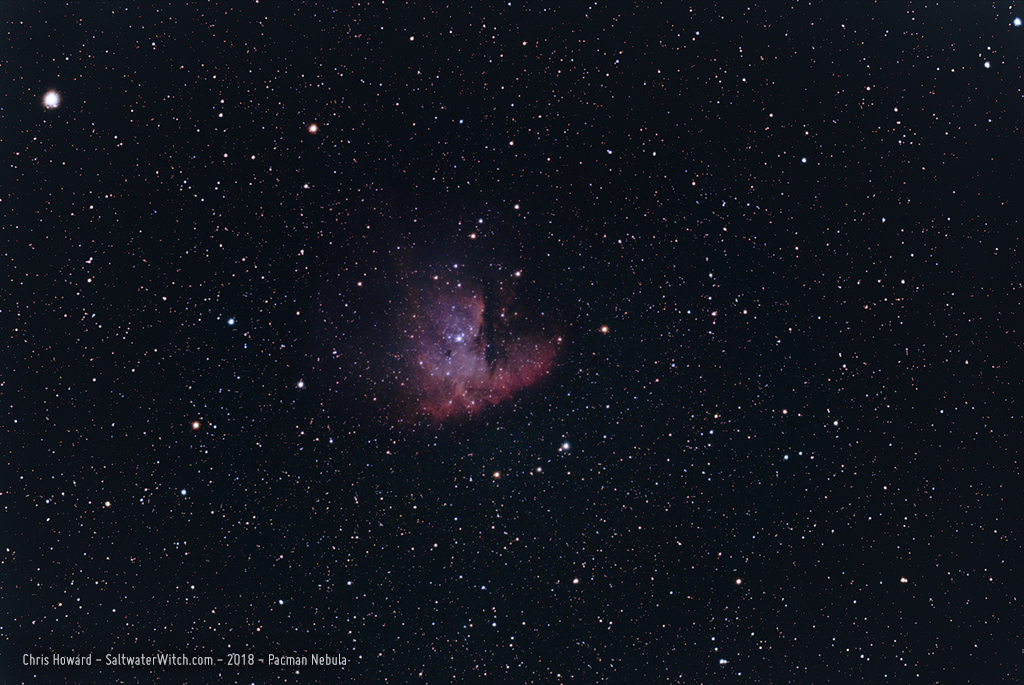
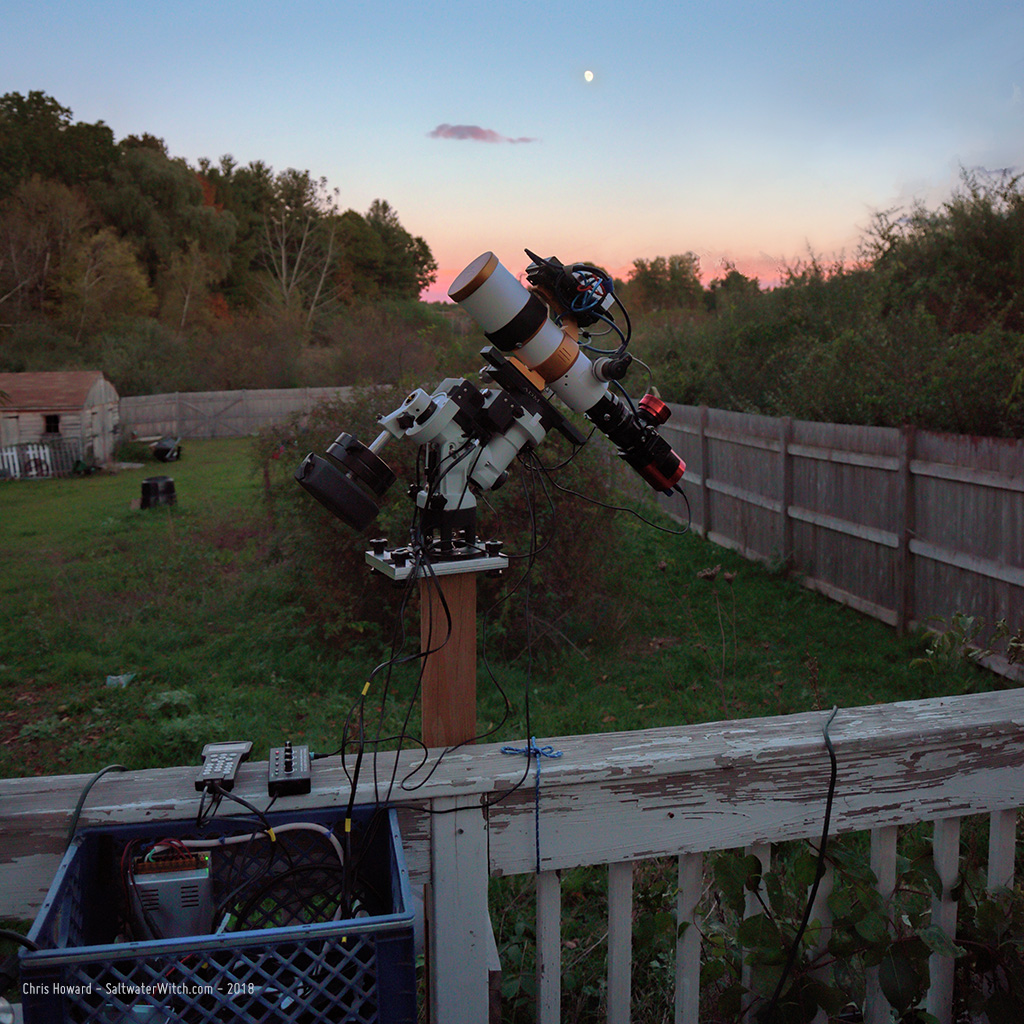
Posted October 21, 2018
Astro Session: October 12, 2018
Wide-field of the Wizard Nebula surrounding the open star cluster NGC 7380 in the constellation Cepheus, about 7,200 lightyears aways from us. I reduced the saturation so that you hardly notice the differences in the RGB mix, mostly R and B because this is a bi-color set with Ha and OIII. I think I prefer this reduced color or even a completely desaturated (grayscale) version. There are so many stars in this image and I'm not a fan of the off-color red and blue stars you get with narrowband. Also in this shot, I particular like the dark band at the top left. These "dark fog" or dark nebula regions consist of interstellar gas and dust that absorb the light from surrounding stars, and the constellation Cepheus has some famous dark cloudy areas, B 174, 150, and several around IC 1396. (16 x 300 second exposures in Ha and OIII, Atik 414EX mono CCD, Astronomik 12nm Ha, OIII filters, William Optics ZS61 + WO Flat F6A f/4.7, CEM25P EQ mount, Orion OAG + ZWO ASI120MM-Mini guide cam, Stellarmate OS (INDI/KStars/Ekos) running on Raspberry Pi 3b+).
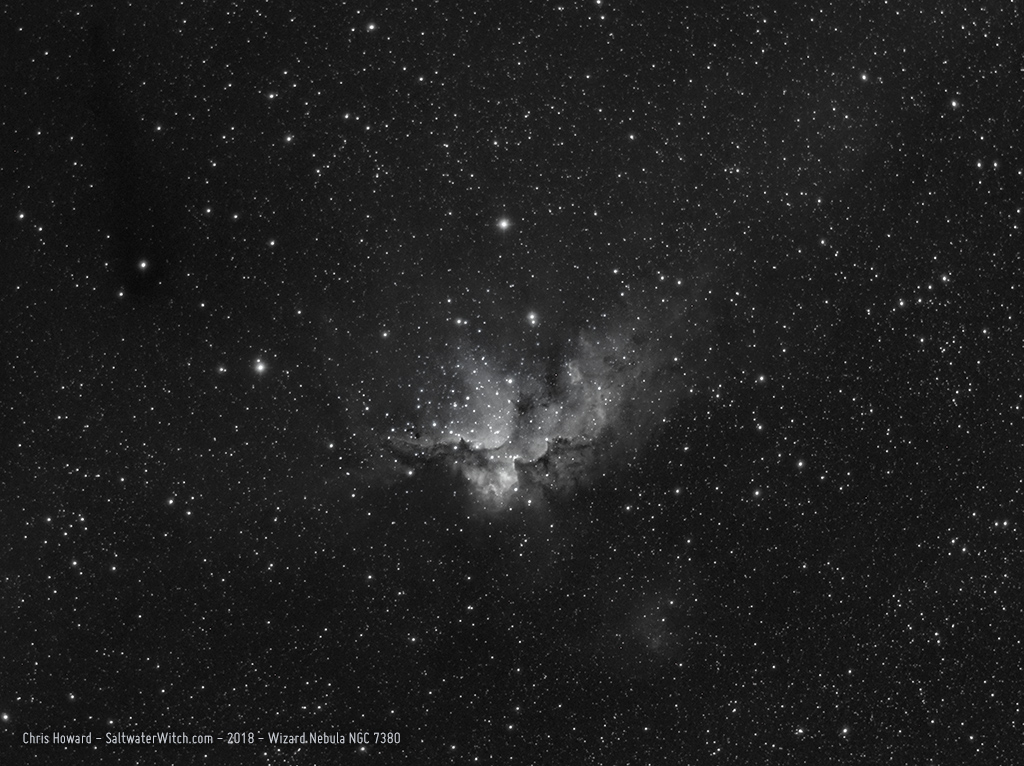
Posted October 12, 2018
Astro Session: July 18, 2018
Here's NGC 281 ("Pacman Nebula") in the Hubble Palette (SII, Ha, OIII -> RGB). NGC 281 is an emission nebula, about 9,200 lightyears away in the constellation Cassiopeia. I re-stacked and reprocessed some hydrogen-alpha, oxygen-3, and sulphur-2 image data I shot several months ago, and I'm happier with this latest result than I was then. It's called the Pacman Nebula because it sort of looks like the classic video game character. (6 x 1200 second exposures in Ha, 5 x 1200 sec OIII & SII with 16 dark frames, Atik 414EX mono CCD, Astronomik 12nm Ha, OIII, SII, William Optics GT81, CEM25P EQ mount, WO 50mm guidescope with ZWO ASI120S-MM guide cam, INDI/KStars/Ekos observatory control).
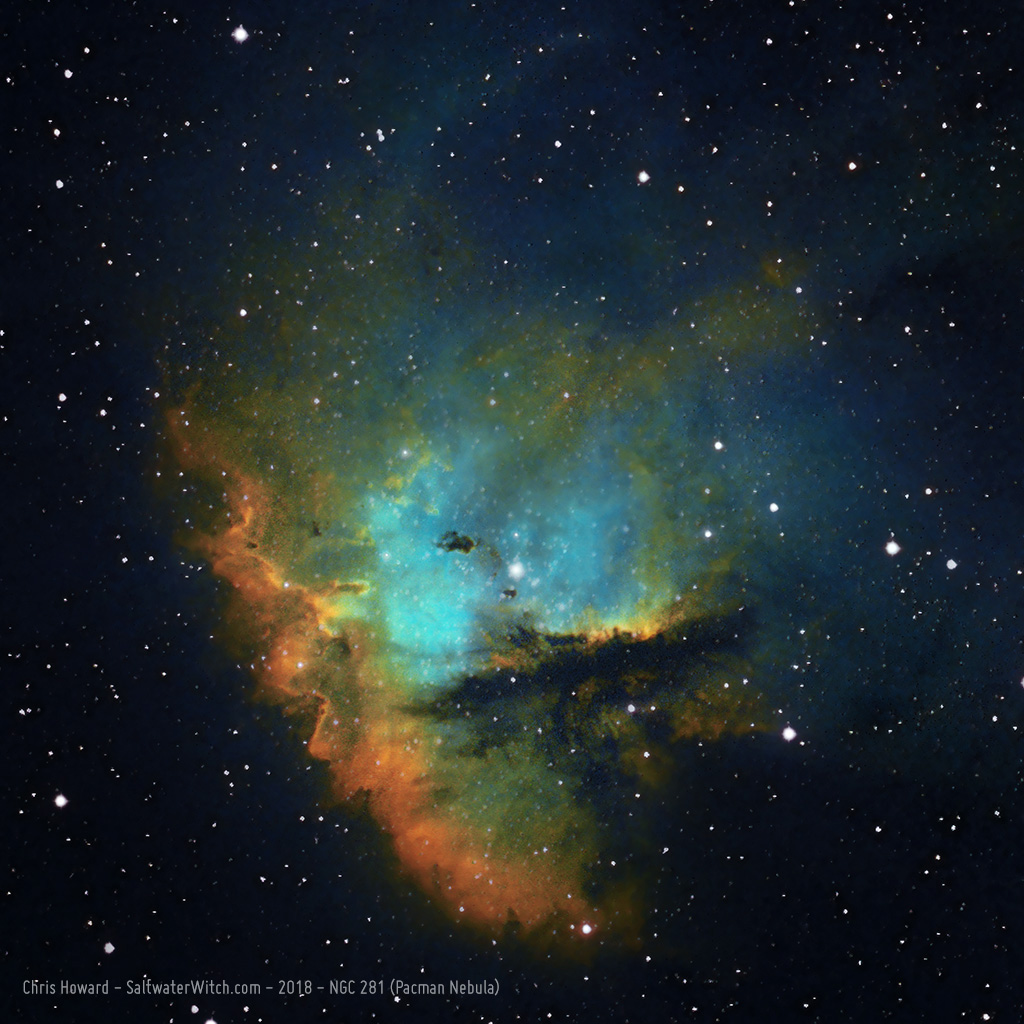
Posted July 18, 2018
Astro Session: July 9, 2018
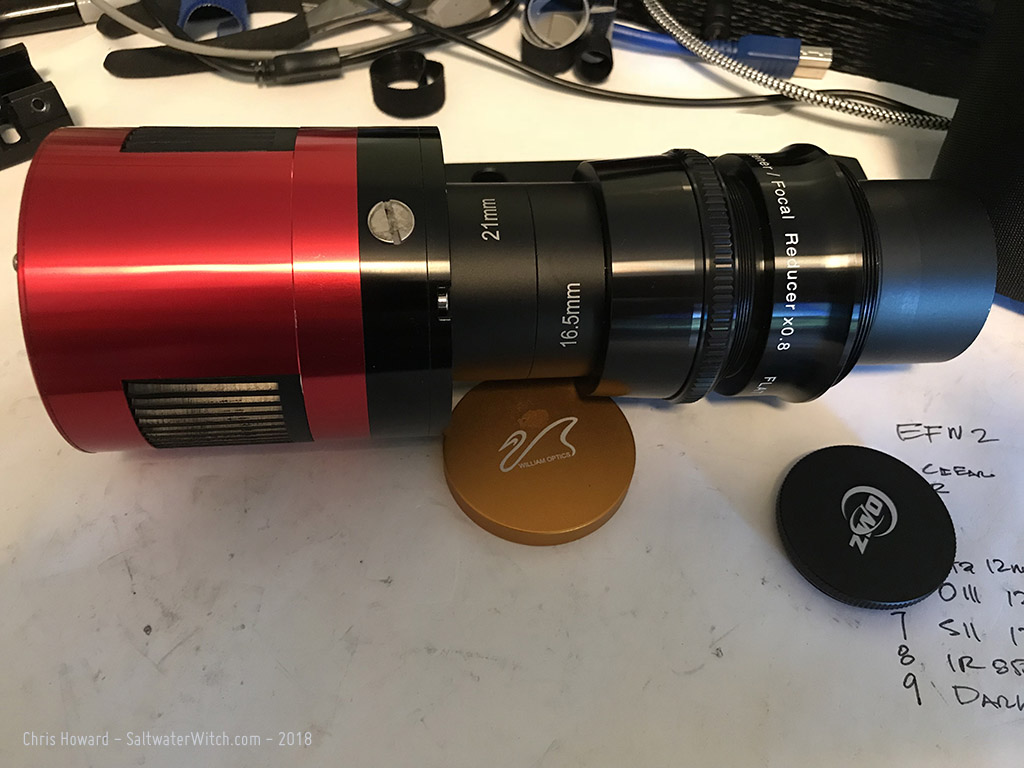 I recently bought the William Optics FLAT 6A II, and finally made it out under the stars to take some sub-exposures. I paired it with my GT-81 and ZWO ASI071MC color CMOS camera. The FLAT 6A II is a 0.8x reducer/field flattener; it's adjustable for different focal lengths, and so far, with my limited use, it appears to be quite a leap over the old William Optics F6-A I've used for a few years. The ASI071 has an APS-C sized sensor, and anyone with a large sensor astro camera or DSLR knows if you don't want field curvature with your refractor you need some sort of flattener. The FLAT6AII design makes it easy to dial in the correct distance for the scope you're using. The old reducer/flattener worked, but I had to test out a dozen different flattener to sensor distances, and still had to do some cropping and processing to fix the corners. This new FLAT 6AII provides a fairly flat field across the entire view. Equipment: William Optics GT-81 + FLAT 6A II 0.8x reducer f/4.7, ZWO ASI071MC-Cool color CMOS camera - gain 0 offset 8, ZWO ASI120MM-S Guide Cam + 130mm guide scope.
I recently bought the William Optics FLAT 6A II, and finally made it out under the stars to take some sub-exposures. I paired it with my GT-81 and ZWO ASI071MC color CMOS camera. The FLAT 6A II is a 0.8x reducer/field flattener; it's adjustable for different focal lengths, and so far, with my limited use, it appears to be quite a leap over the old William Optics F6-A I've used for a few years. The ASI071 has an APS-C sized sensor, and anyone with a large sensor astro camera or DSLR knows if you don't want field curvature with your refractor you need some sort of flattener. The FLAT6AII design makes it easy to dial in the correct distance for the scope you're using. The old reducer/flattener worked, but I had to test out a dozen different flattener to sensor distances, and still had to do some cropping and processing to fix the corners. This new FLAT 6AII provides a fairly flat field across the entire view. Equipment: William Optics GT-81 + FLAT 6A II 0.8x reducer f/4.7, ZWO ASI071MC-Cool color CMOS camera - gain 0 offset 8, ZWO ASI120MM-S Guide Cam + 130mm guide scope.
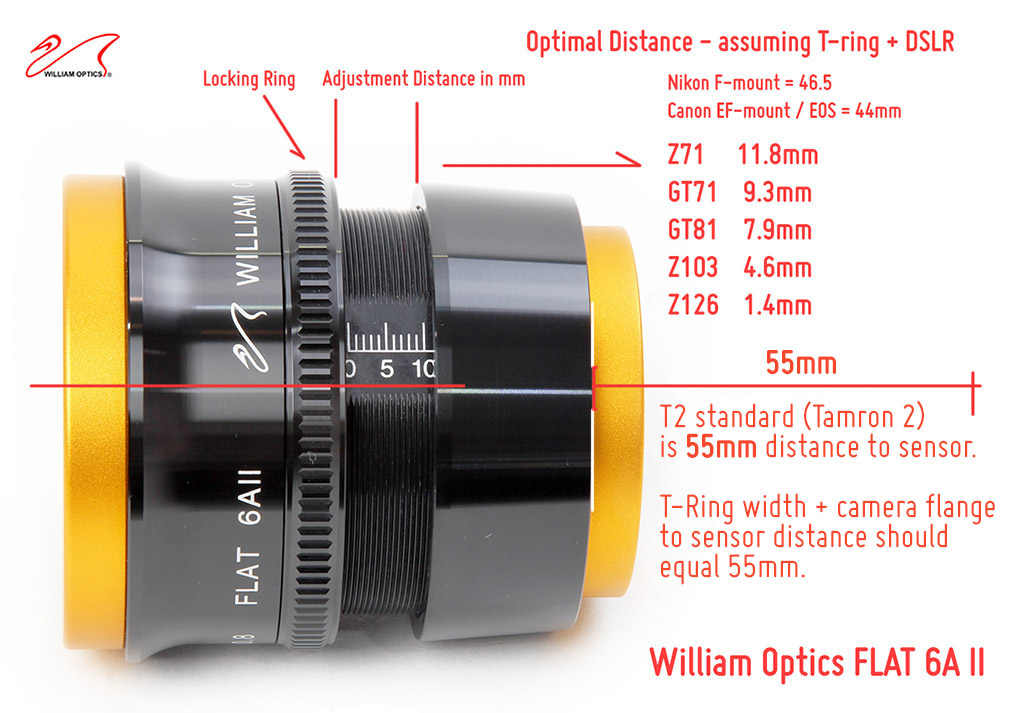 Testing:
Testing:
With the GT81 and ASI071 I get a 3.54° x 2.35° field of view, and I can capture some big chunks of the night sky. Here are three from the last two nights: [1] the Pelican Nebula (IC 5070) and the edge of the North America Nebula (NGC7000) at the bottom, [2] IC 1396 nebula with the Elephant's Trunk at the top and the Garnet Star bottom left, and [3] M31, our galactic neighbor, the Andromeda Galaxy.
Pelican Nebula image info: ZWOASI071MC 39 x 240 second color subs stacked in DSS, processed in PSCC2018
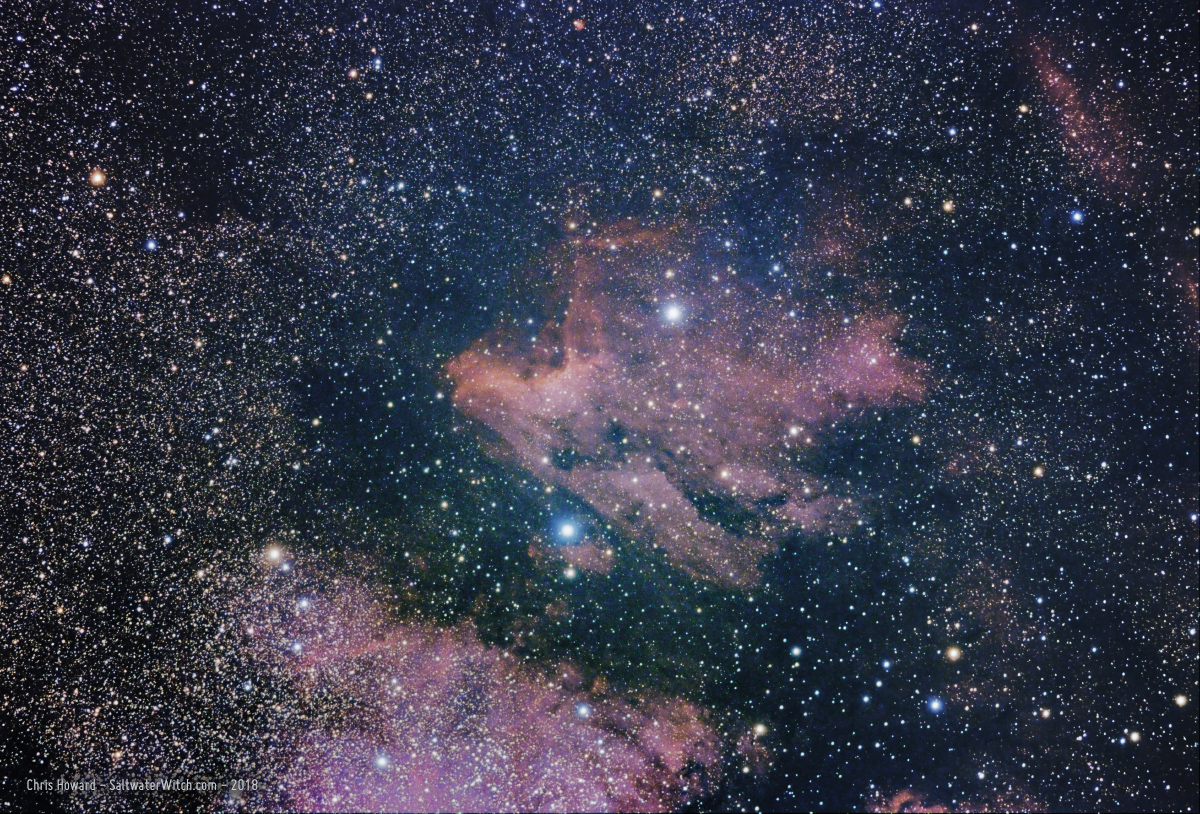
IC 1396 region image info: ZWOASI071MC 21 x 300 second color subs stacked in DSS, processed in PSCC2018
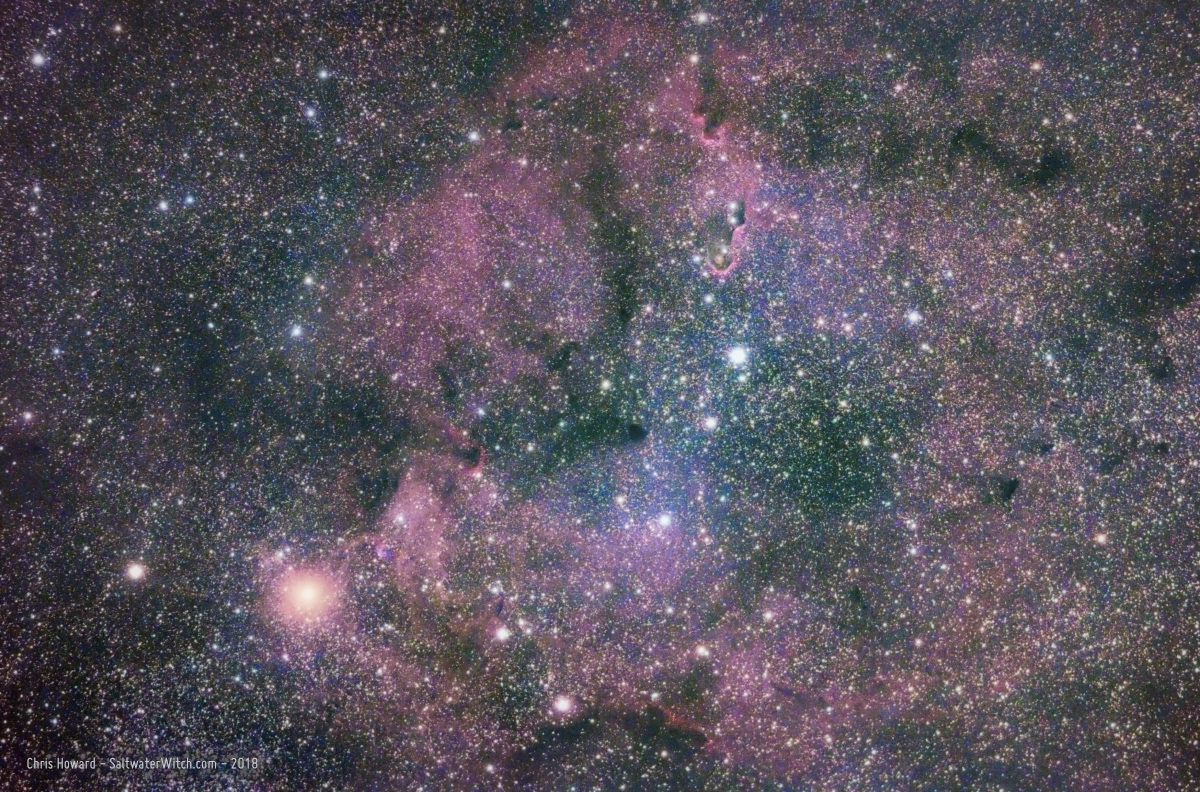
The Andromeda Galaxy. The last time I photographed Andromeda (M31) was 2015, maybe fall of 2014? It's been a while. I was using a DSLR--that was the only camera I had, and I had it on a terribly-used Celestron CG-5 equatorial mount with some aftermarket RA/DEC motors. By "terribly-used" I mean you could drive a truck through the gear backlash. Even so, I still managed to get some decent 30-second exposures of Andromeda, Orion Nebula, and other big bright targets in the sky. Well, I'm back with our galactic neighbor, and with much better gear: 192 x 120-second sub-exposures stacked in DSS, processed in PSCC2018, ZWO ASI071MC camera at -10C, William Optics GT81 APO, iOptron CEM25P EQ mount.
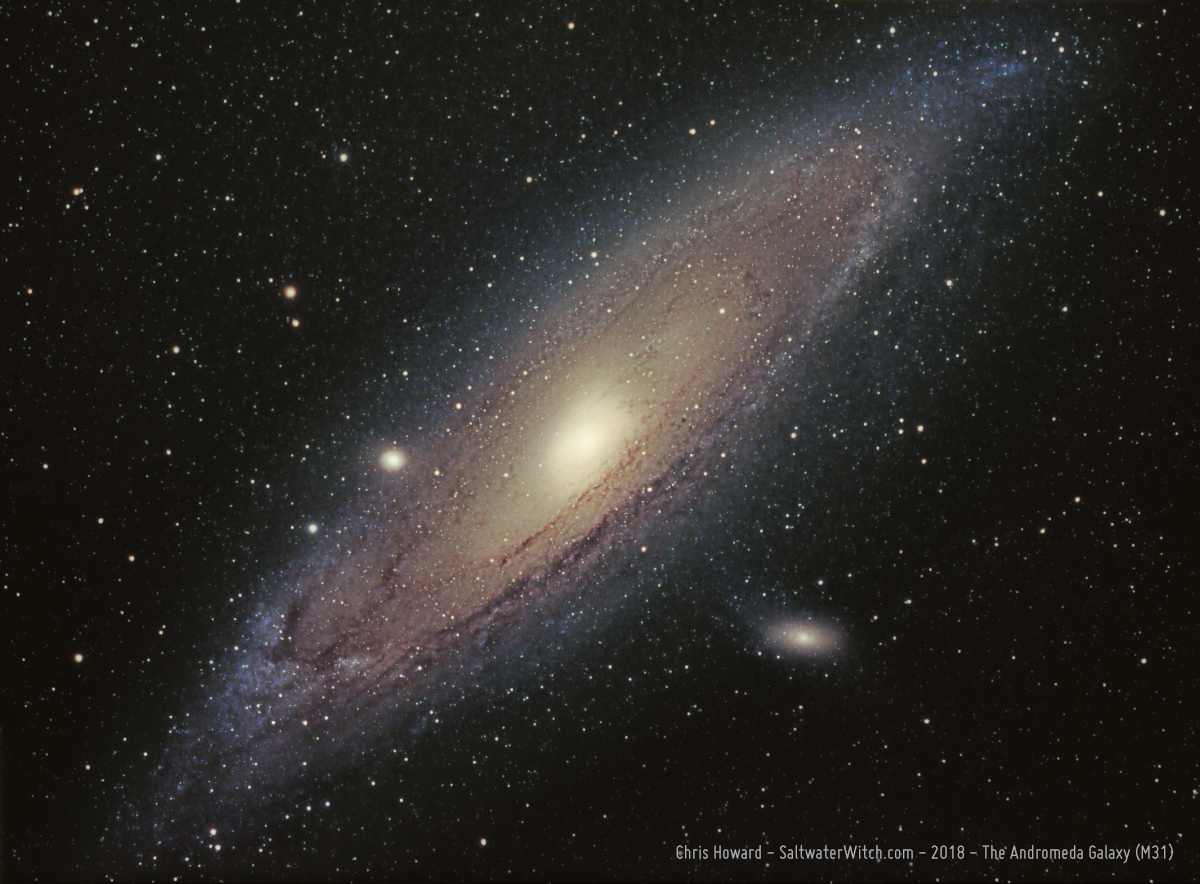
Posted July 9, 2018
Astro Session: July 7, 2018
Our galactic neighborhood, looking toward the center, with 13 stacked 15 second exposures, Nikon D750, Rokinon 10mm f/2.8 lens. What's crazy is this is with a decent DSLR camera, lens, a tripod, and some free image stacking software (DSS). I did the stretching in Photoshop CC--"stretching" is when you adjust contrast, intensity values, to bring out the features of whatever you're shooting--in this case the north end of the Milky Way Galaxy, our home. Let me point out some interesting features: starting at the left, that vivid red star is the "Garnet Star" (Mu Cephei), and that's right next to some cool nebulosity that includes the Elephant's Trunk Nebula (IC 1396), a little ways along, you see that blocky reddish region? That's the North America Nebula (NGC 7000) with the star Deneb (19th brightest star in the night sky). Deneb forms the northernmost (leftmost in this shot) point of the famous "Summer Triangle". The other two points are Vega, the 5th brightest star in the night sky (to the right and above the Milky Way core in this shot), and Altair (12th brightest) a little more to the right and below the Milky Way core. Moving along the galaxy to that bright region on the bottom side of the core, about halfway between Altair and the powerlines--if you really zoom in, you'll see the Wild Duck Cluster (M11). Now look just left of where the powerlines cross, those grayish-pink cloudy areas? That's where you will find the Eagle Nebula (Messier 16, NGC 6611) and the Swan Nebula (M17). That bright point of light in the middle of the powerlines is the planet Saturn, which is moving along the ecliptic and right now it's in a pretty good place for viewing. Just right of that are a few more cloudy areas. That's where you would look for the Lagoon Nebula (M8, NGC 6523) and Trifid Nebula (M20, NGC 6514). Somewhere along the Milky Way--this is where you will mostly likely find me focusing my telescope all the through the summer and fall. I almost see this shot as a map of places to visit from afar, and the cool thing is you really don't need to setup the astro gear for this. You can create your own galaxy map, as long as your camera can handle long exposures (not that long, only 15 seconds) and you have it on a tripod with a remote shutter control. And this is only part of the sky from where I'm standing on our little planet! Another way to put this image in perspective is here in the northern hemisphere, around 43° latitude, I don't have enough of a view south (blocked by hills and trees) to see Sagittarius A*, which marks the center of our galaxy, and this far north there's a sky full of other galaxies, a large section of our own galaxy, nebulae, and other deep space objects that I can't ever see from here--that I would have to travel below the equator to see. Some day!
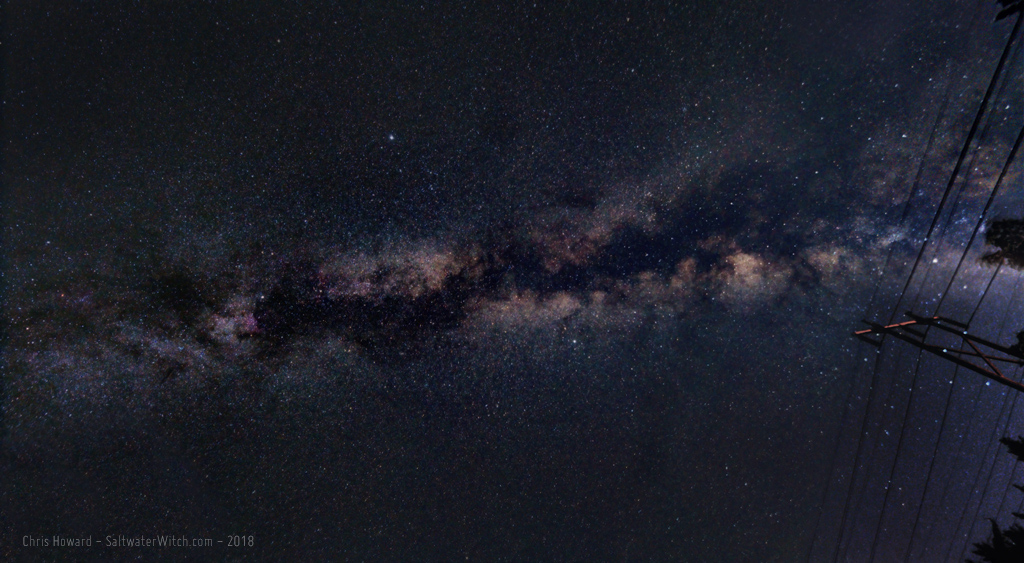
Posted July 7, 2018
Astro Session: July 3, 2018
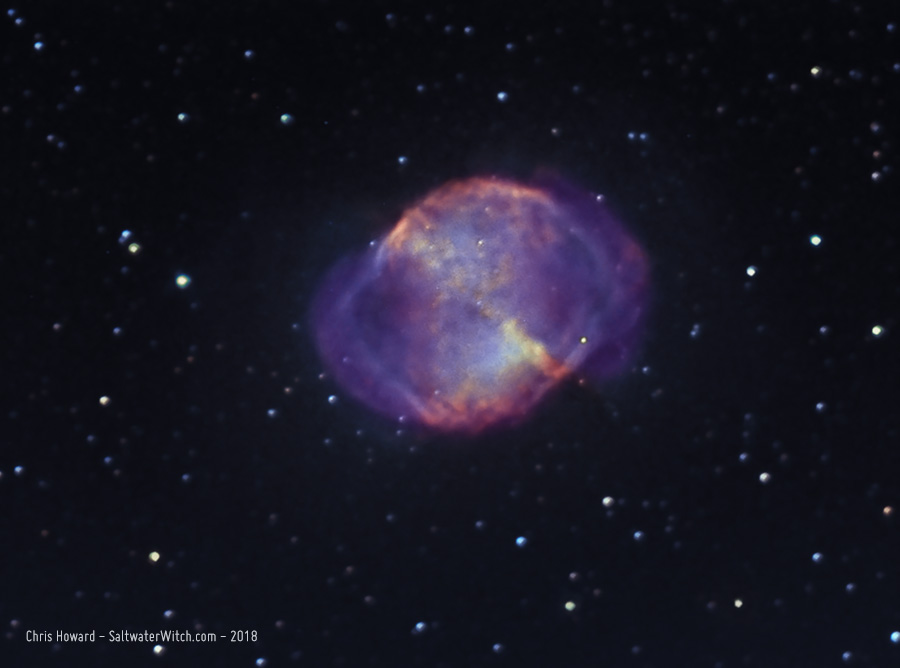 The Dumbbell Nebula (M27, NGC 6853), also called the Apple Core, is a planetary nebula in the constellation Vulpecula. I setup the AstroTech with 1350mm focal length, paired with the Atik 414EX mono CCD. This gives me .98" / pixel resolution and oversampling, but still managed to get some detail out of the nebula. (Imaging info: 63 x 90 second subs in OIII, 96 x 60 sec. subs of Ha. + 20 dark frames stacked in Nebulosity, processing in PSCC2018. Equipment: AstroTech AT6RC f/9 Ritchey-Chrétien, Atik 414EX mono CCD, 7nm Optolong 2" Ha filter, 8.5nm Baader 2" OIII filter, Orion Atlas EQ-G Mount, ZWO ASI120MM-S Guide Cam + WO 50/200mm guide scope)
The Dumbbell Nebula (M27, NGC 6853), also called the Apple Core, is a planetary nebula in the constellation Vulpecula. I setup the AstroTech with 1350mm focal length, paired with the Atik 414EX mono CCD. This gives me .98" / pixel resolution and oversampling, but still managed to get some detail out of the nebula. (Imaging info: 63 x 90 second subs in OIII, 96 x 60 sec. subs of Ha. + 20 dark frames stacked in Nebulosity, processing in PSCC2018. Equipment: AstroTech AT6RC f/9 Ritchey-Chrétien, Atik 414EX mono CCD, 7nm Optolong 2" Ha filter, 8.5nm Baader 2" OIII filter, Orion Atlas EQ-G Mount, ZWO ASI120MM-S Guide Cam + WO 50/200mm guide scope)
